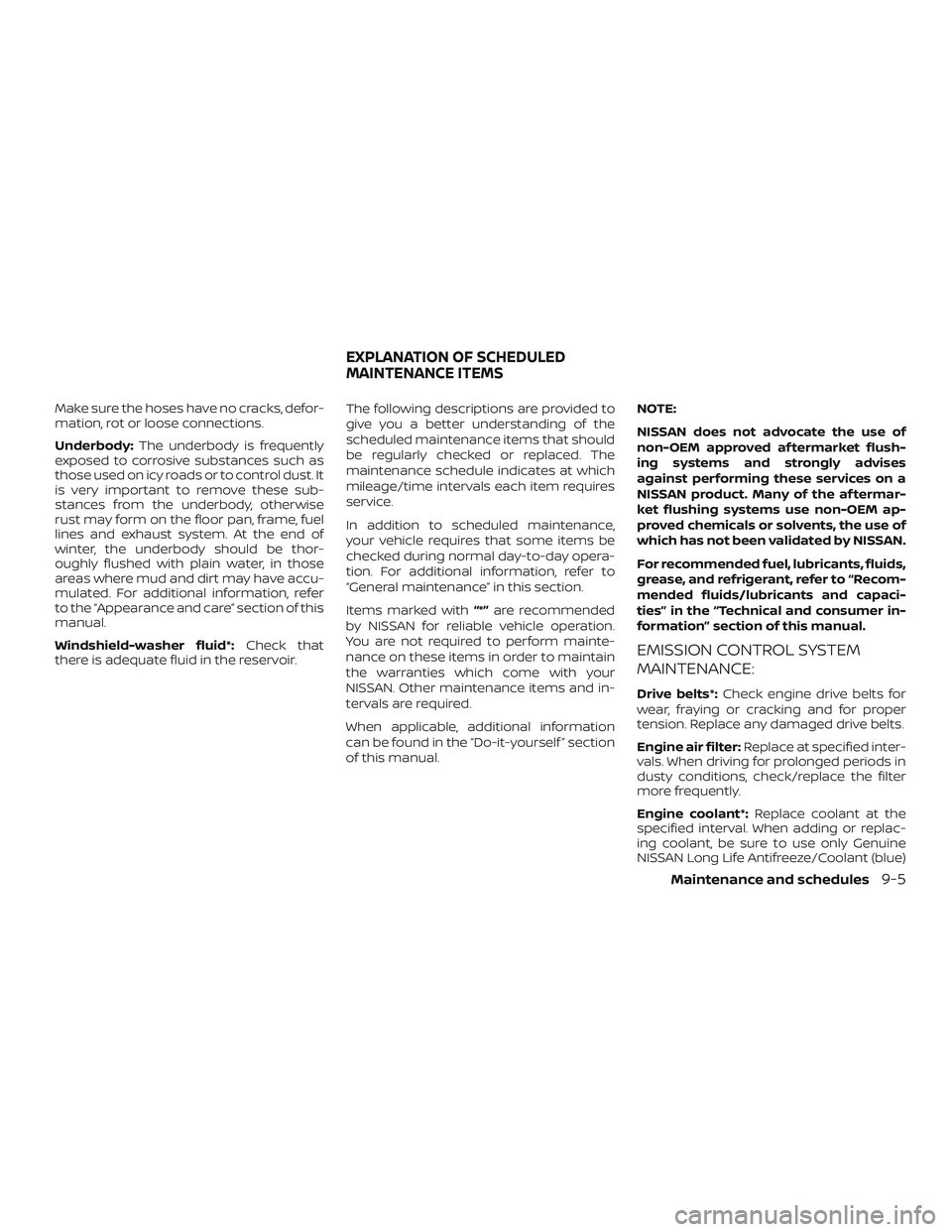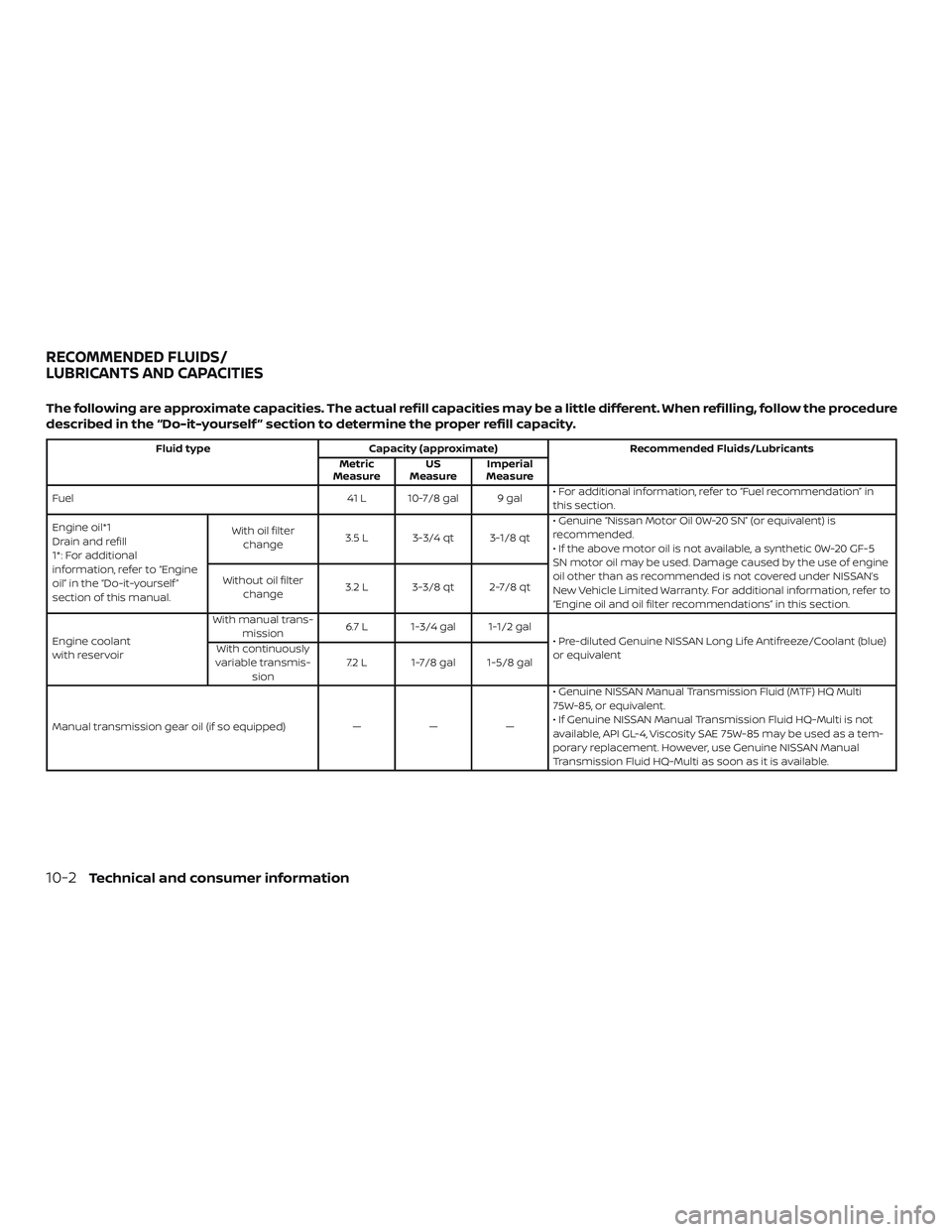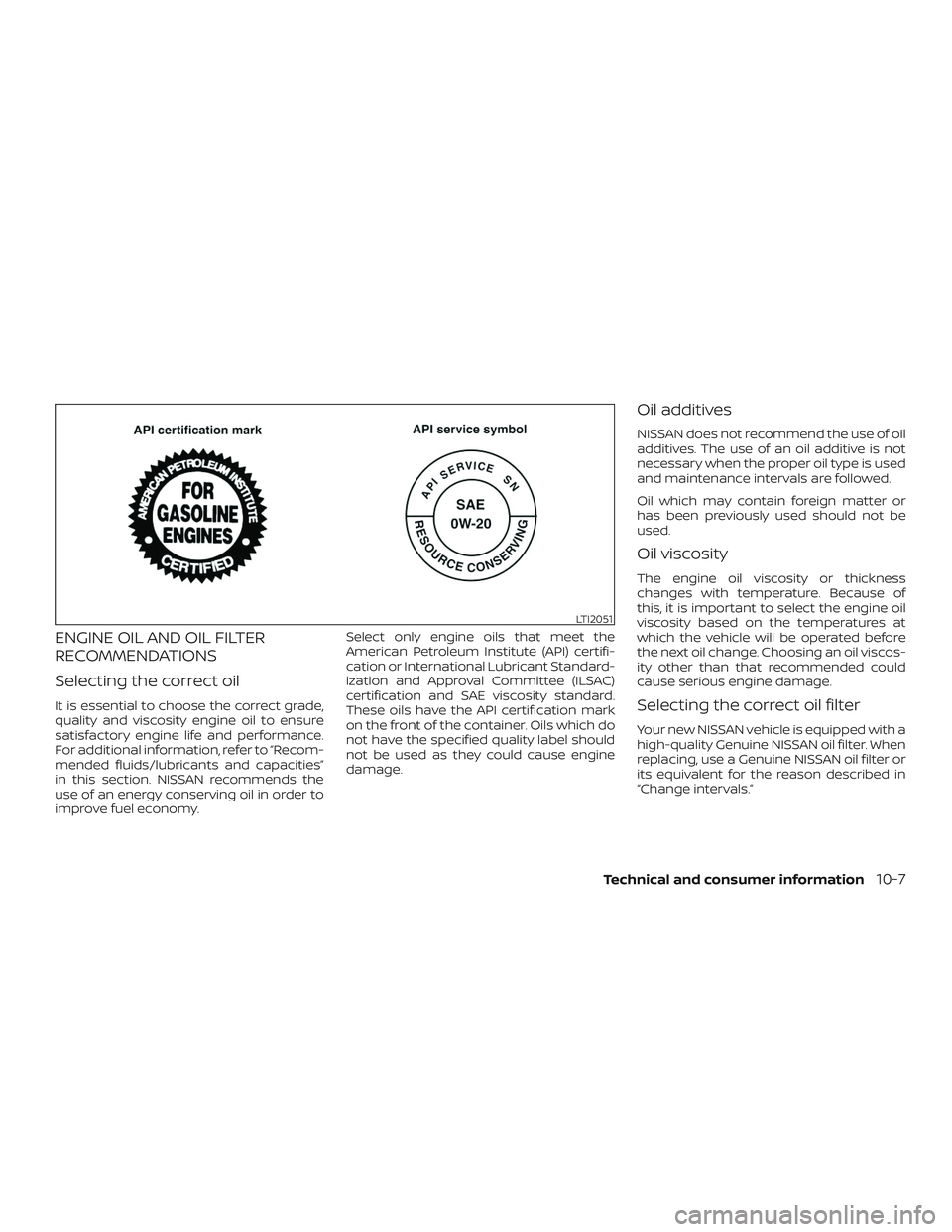2019 NISSAN VERSA fuel cap
[x] Cancel search: fuel capPage 325 of 372

Make sure the hoses have no cracks, defor-
mation, rot or loose connections.
Underbody:The underbody is frequently
exposed to corrosive substances such as
those used on icy roads or to control dust. It
is very important to remove these sub-
stances from the underbody, otherwise
rust may form on the floor pan, frame, fuel
lines and exhaust system. At the end of
winter, the underbody should be thor-
oughly flushed with plain water, in those
areas where mud and dirt may have accu-
mulated. For additional information, refer
to the “Appearance and care” section of this
manual.
Windshield-washer fluid*: Check that
there is adequate fluid in the reservoir. The following descriptions are provided to
give you a better understanding of the
scheduled maintenance items that should
be regularly checked or replaced. The
maintenance schedule indicates at which
mileage/time intervals each item requires
service.
In addition to scheduled maintenance,
your vehicle requires that some items be
checked during normal day-to-day opera-
tion. For additional information, refer to
“General maintenance” in this section.
Items marked with
“*”are recommended
by NISSAN for reliable vehicle operation.
You are not required to perform mainte-
nance on these items in order to maintain
the warranties which come with your
NISSAN. Other maintenance items and in-
tervals are required.
When applicable, additional information
can be found in the “Do-it-yourself ” section
of this manual. NOTE:
NISSAN does not advocate the use of
non-OEM approved af termarket flush-
ing systems and strongly advises
against performing these services on a
NISSAN product. Many of the af termar-
ket flushing systems use non-OEM ap-
proved chemicals or solvents, the use of
which has not been validated by NISSAN.
For recommended fuel, lubricants, fluids,
grease, and refrigerant, refer to “Recom-
mended fluids/lubricants and capaci-
ties” in the “Technical and consumer in-
formation” section of this manual.
EMISSION CONTROL SYSTEM
MAINTENANCE:
Drive belts*:
Check engine drive belts for
wear, fraying or cracking and for proper
tension. Replace any damaged drive belts.
Engine air filter: Replace at specified inter-
vals. When driving for prolonged periods in
dusty conditions, check/replace the filter
more frequently.
Engine coolant*: Replace coolant at the
specified interval. When adding or replac-
ing coolant, be sure to use only Genuine
NISSAN Long Life Antifreeze/Coolant (blue)
EXPLANATION OF SCHEDULED
MAINTENANCE ITEMS
Maintenance and schedules9-5
Page 326 of 372

or equivalent with the proper mixture. (For
additional information on the proper mix-
ture for your area, refer to “Engine cooling
system” in the “Do-it-yourself ” section of
this manual.)
NOTE: Mixing any other type of coolant
or the use of non-distilled water may re-
duce the recommended service interval
of the coolant.
Engine oil and oil filter:Replace engine oil
and oil filter at the specified intervals. For
recommended oil grade and viscosity refer
to “Recommended fluids/lubricants and
capacities” in the “Technical and consumer
information” section of this manual.
Fuel lines*: Check the fuel hoses, piping
and connections for leaks, looseness, or
deterioration. Tighten connections or re-
place parts as necessary.
Spark plugs: Replace at specified intervals.
Install new plugs of the type as originally
equipped.CHASSIS AND BODY
MAINTENANCE:
Brake lines and cables: Visually inspect for
proper installation. Check for chafing,
cracks, deterioration, and signs of leaking.
Replace any deteriorated or damaged
parts immediately.
Brake pads, rotors, drums and linings:
Check for wear, deterioration and fluid
leaks. Replace any deteriorated or dam-
aged parts immediately.
Exhaust system: Visually inspect the ex-
haust pipes, muffler and hangers for leaks,
cracks, deterioration, and damage. Tighten
connections or replace parts as necessary.
Steering gear and linkage, axle and sus-
pension parts, drive shaf t boots: Check
for damage, looseness, and leakage of oil
or grease. Under severe driving conditions,
inspect more frequently.
Tire rotation: Tires should be rotated every
5,000 miles (8,000 km) according to the in-
structions under “General maintenance” in
this section. When rotating tires, check for
damage and uneven wear. Replace if nec-
essary. Transmission fluid/oil:
Visually inspect for
signs of leakage at specified intervals.
If towing a trailer, using a camper or car-top
carrier, or driving on rough or muddy roads,
replace the CVT fluid every 60,000 miles
(96,000 km) or request the dealer to inspect
the fluid deterioration data using a CON-
SULT. If the deterioration data is more than
210000, replace the CVT fluid.
9-6Maintenance and schedules
Page 337 of 372

10 Technical and consumer information
Recommended fluids/lubricants and
capacities...................................... 10-2
Fuel recommendation ....................... 10-4
Engine oil and oil filter
recommendations .......................... 10-7
Air conditioner system refrigerant and
oil recommendations .......................10-8
Specifications .................................. 10-9
Engine ...................................... 10-9
Wheels and tires ............................ 10-10
Dimensions and weights ...................10-10
When traveling or registering in another
country ......................................... 10-11
Vehicle identification ........................... 10-11
Vehicle Identification Number (VIN)
plate ........................................ 10-11
Vehicle identification number
(chassis number) ............................ 10-11
Engine serial number ....................... 10-12
F.M.V.S.S. certification label ..................10-12Emission control information label
.........10-12
Tire and Loading Information label .........10-13
Air conditioner specification label ...........10-13
Installing front license plate ....................10-13
Vehicle loading information ...................10-14
Terms ...................................... 10-14
Vehicle load capacity ....................... 10-15
Loading tips ................................ 10-17
Measurement of weights ...................10-17
Towing a trailer ................................ 10-18
Flat towing ................................. 10-18
Uniform tire quality grading ....................10-18
Emission control system warranty .............10-19
Reporting safety defects ......................10-20
Readiness for Inspection/Maintenance (I/M)
test ............................................ 10-21
Event Data Recorders (EDR) ....................10-21
Owner’s Manual/Service Manual order
information ................................... 10-22
Page 338 of 372

The following are approximate capacities. The actual refill capacities may be a little different. When refilling, follow the procedure
described in the “Do-it-yourself ” section to determine the proper refill capacity.
Fluid typeCapacity (approximate) Recommended Fluids/Lubricants
Metric
Measure US
Measure Imperial
Measure
Fuel 41 L 10-7/8 gal 9 gal• For additional information, refer to “Fuel recommendation” in
this section.
Engine oil*1
Drain and refill
1*: For additional
information, refer to “Engine
oil” in the “Do-it-yourself ”
section of this manual. With oil filter
change 3.5 L 3-3/4 qt 3-1/8 qt • Genuine “Nissan Motor Oil 0W-20 SN” (or equivalent) is
recommended.
• If the above motor oil is not available, a synthetic 0W-20 GF-5
SN motor oil may be used. Damage caused by the use of engine
oil other than as recommended is not covered under NISSAN’s
New Vehicle Limited Warranty. For additional information, refer to
“Engine oil and oil filter recommendations” in this section.
Without oil filter
change 3.2 L 3-3/8 qt 2-7/8 qt
Engine coolant
with reservoir With manual trans-
mission 6.7 L 1-3/4 gal 1-1/2 gal
• Pre-diluted Genuine NISSAN Long Life Antifreeze/Coolant (blue)
or equivalent
With continuously
variable transmis- sion 7.2 L 1-7/8 gal 1-5/8 gal
Manual transmission gear oil (if so equipped) ———• Genuine NISSAN Manual Transmission Fluid (MTF) HQ Multi
75W-85, or equivalent.
• If Genuine NISSAN Manual Transmission Fluid HQ-Multi is not
available, API GL-4, Viscosity SAE 75W-85 may be used as a tem-
porary replacement. However, use Genuine NISSAN Manual
Transmission Fluid HQ-Multi as soon as it is available.
RECOMMENDED FLUIDS/
LUBRICANTS AND CAPACITIES
10-2Technical and consumer information
Page 343 of 372

ENGINE OIL AND OIL FILTER
RECOMMENDATIONS
Selecting the correct oil
It is essential to choose the correct grade,
quality and viscosity engine oil to ensure
satisfactory engine life and performance.
For additional information, refer to “Recom-
mended fluids/lubricants and capacities”
in this section. NISSAN recommends the
use of an energy conserving oil in order to
improve fuel economy.Select only engine oils that meet the
American Petroleum Institute (API) certifi-
cation or International Lubricant Standard-
ization and Approval Committee (ILSAC)
certification and SAE viscosity standard.
These oils have the API certification mark
on the front of the container. Oils which do
not have the specified quality label should
not be used as they could cause engine
damage.
Oil additives
NISSAN does not recommend the use of oil
additives. The use of an oil additive is not
necessary when the proper oil type is used
and maintenance intervals are followed.
Oil which may contain foreign matter or
has been previously used should not be
used.
Oil viscosity
The engine oil viscosity or thickness
changes with temperature. Because of
this, it is important to select the engine oil
viscosity based on the temperatures at
which the vehicle will be operated before
the next oil change. Choosing an oil viscos-
ity other than that recommended could
cause serious engine damage.
Selecting the correct oil filter
Your new NISSAN vehicle is equipped with a
high-quality Genuine NISSAN oil filter. When
replacing, use a Genuine NISSAN oil filter or
its equivalent for the reason described in
“Change intervals.”
LTI2051
Technical and consumer information10-7
Page 359 of 372

11 Index
A
Air bag (See supplemental restraint
system) .................... .1-42
Air bag system Front (See supplemental front impact air
bagsystem)............... .1-52
Air bag warning labels ............1-60
Airbagwarninglight..........1-61, 2-18
Air bag warning light,
supplemental ..............1-61, 2-18
Air cleaner housing filter ...........8-17
Air conditioner Air conditioner operation ........4-18
Air conditioner service ..........4-22
Air conditioner specification label . .10-13
Air conditioner system refrigerant and oil
recommendations ............10-8
Air conditioner system refrigerant
recommendations ............10-8
Heater and air conditioner controls .4-14
Servicing air conditioner ........4-22
Air flow charts .................4-19
Alarm system
(See vehicle security system) ........2-21
Anchor point locations ...........1-25
Antenna ....................4-42
Antifreeze ...................5-34
Anti-lock brake warning light ........2-13
Anti-lock Braking System (ABS) ......5-30
Audible reminders ..............2-21
Audio system .................4-22 AM/FMradio ............4-27,4-29
AM radio operation
............4-29
AMradioreception............4-23
Auxliliary (AUX) devices operation . . .4-31
Bluetooth® audio .............4-38
FM radio operation ............4-30
FMradioreception............4-22
iPod®Player................4-35
iPod® player operation .........4-35
Radio ....................4-22
Steering wheel audio control
switch....................4-42
USB Connections .............4-33
USBinterface...............4-32
USB (Universal Serial Bus) Connection
Port.....................4-32
Automatic Automatic power window switch . . .2-34
Automatic door locks .............3-8
B
Battery..................5-34,8-13 Charge warning light ...........2-14
Battery replacement ............8-22
Keyfob................8-22,8-23
NISSAN Intelligent Key® .........8-24
Before starting the engine .........5-14
Belt(Seedrivebelt)..............8-15
Bluetooth® audio ...............4-38
Bluetooth® hands-free phone system . .4-46 Bluetooth® connections ........4-60Connecting procedure
.........4-51
Phone indicators .............4-50
Text messaging ..............4-57
Voice commands ............4-52
Booster seats .................1-38
Brake Anti-lock Braking System (ABS) ....5-30
Brakefluid.................8-10
Brakelight(Seestoplight).......8-28
Brakesystem...............5-30
Brakewarninglight............2-13
Brakewearindicators.......2-21,8-19
Parking brake operation ........5-23
Self-adjustingbrakes ..........8-19
Brakeassist..................5-31
Brakefluid...................8-10
B r
akes......................8-19
Brakesystem.................5-30
Break-in schedule ..............5-26
Brightness/contrast button .........4-7
Brightness control Instrument panel .............2-26
Bulb check/instrument panel .......2-13
Bulb replacement ..............8-28
C
Capacities and recommended fuel/
lubricants....................10-2
Cargo
(See vehicle loading information) . . . .10-14
Car phone or CB radio ...........4-46
Page 360 of 372

Childrestraints........1-18, 1-19, 1-20, 1-23LATCH (Lower Anchors and Tethers for
CHildren)System............. .1-23
Precautions on child
restraints .........1-20, 1-27, 1-33, 1-38
Top tether strap anchor point
locations.................. .1-25
Child safety rear door lock ..........3-8
Chimes, audible reminders .........2-21
Cleaningexteriorandinterior......7-2,7-4
Clockset.....................4-5
Clutch Clutchfluid..................8-11
Coldweatherdriving.............5-34
Continuously Variable Transmission
(CVT) .....................5-9,5-16
Continuously Variable Transmission
(CVT) fluid ..................8-10
Driving with Continuously Variable
Transmission (CVT) ..........5-9,5-16
Control panel buttons .............4-3
Brightness/contrast button .......4-7
Controls Audio controls (steering wheel) ....4-42
Heater and air conditioner controls . .4-14
Coolant Capacities and recommended
fuel/lubricants...............10-2
Changing engine coolant .........8-6
Checking engine coolant level ......8-6
Engine coolant temperature gauge . .2-9
Corrosionprotection..............7-7
Cruisecontrol .................5-24
Cupholders...................2-31
Curtain side-impact and rollover air
bag........................1-58 D
Defroster switch Rearwindowdefrosterswitch.....2-24
Dimensions and weights ..........10-10
Dimmer switch for instrument panel . . .2-26
Display controls
(see control panel buttons) ..........4-3
Door locks ..................3-6,3-7
Door open warning light ...........2-14
Drivebelt ....................8-15
Driving Cold weather driving ...........5-34
Driving with Continuously Variable
Transmission (CVT) ..........5-9,5-16
Driving with manual
transmission .............5-10,5-21
Precautions when starting and
driving.....................5-2
Drivingthevehicle...............5-16
E
Economy - fuel .................5-27
Emergency engine shutoff ..........5-13
Emission control information label . . . .10-12
Emission control system warranty . . . .10-19
Engine Before starting the engine ........5-14
Capacities and recommended
fuel/lubricants...............10-2
Changing engine coolant .........8-6
Changing engine oil ............8-8
Changing engine oil filter .........8-9
Checking engine coolant level ......8-6Checking engine oil level
.........8-7
Engine compartment check
locations...................8-4
Engine coolant temperature gauge . .2-9
Engine cooling system ..........8-5
Engine oil ...................8-7
Engine oil and oil filter
recommendation .............10-7
Engine oil pressure warning light ....2-14
Engine oil viscosity .............10-7
Engine serial number ..........10-12
Engine specifications ...........10-9
Starting the engine ............5-14
Engine coolant temperature gauge ....2-9
EventDatarecorders ............10-21
Exhaust gas (Carbon monoxide) .......5-2
Explanation of maintenance items .....9-2
Explanation of scheduled maintenance
items .......................9-5
Extended storage switch ..........8-22
F
Flasher s
(
Seehazardwarningflasherswitch)....6-2
Flattire....................6-2,6-3
Floormatpositioningaid...........7-6
Fluid Brakefluid..................8-10
Capacities and recommended
fuel/lubricants...............10-2
Clutchfluid..................8-11
Continuously Variable Transmission (CVT)
fluid......................8-10
Engine coolant ...............8-5
11-2
Page 361 of 372

Engine oil...................8-7
F.M.V.S.S. certification label .........10-12
Foglightswitch ................2-27
Front air bag system
(See supplemental restraint system) . . .1-52
Front-door pocket ...............2-29
Frontseats....................1-2
Fuel Capacities and recommended
fuel/lubricants...............10-2
Fuel economy ...............5-27
Fuel-filler cap ................3-30
Fuel-filler door lock opener lever ....3-30
Fuel-filler lid .................3-30
Fuel gauge ..................2-9
Fueloctanerating.............10-6
Fuel recommendation ..........10-4
Loose fuel cap warning ..........2-7
Fuelefficientdrivingtips...........5-26
Fuel-filler door .................3-30
Fuel gauge ....................2-9
Fuses .......................8-19
Fusiblelinks...................8-20
G
Gascap.....................3-30
Gauge Engine coolant temperature gauge . .2-9
Fuel gauge ..................2-9
Odometer ..................2-6
Speedometer ................2-5
Tachometer .................2-8
Trip computer ...............2-10 Trip odometer
.............2-5,2-6
General maintenance .............9-2
Glovebox ....................2-31
H
Hands-free phone system, Bluetooth® . .4-46
Hazard warning flasher switch ........6-2
Headlight and turn signal switch ......2-24
Headlightcontrolswitch...........2-24
Headlights ...................8-26
Headrestraints .................1-6
Heater Heater and air conditioner controls . .4-14
Heater operation ..............4-16
Hood .......................3-27
Horn.......................2-27
I
Ignition switch ..................5-9
Push-button ignition switch .......5-11
Immobilizer system ...........2-21,5-14
Important vehicle information label . . .10-12
Increasing fuel economy ...........5-27
Indicator NISSAN Intelligent Key® battery discharge
indicator...................5-13
Indicator lights and audible reminders
(See warning/indicator lights and audible
reminders) ....................2-18
Instrument brightness control .......2-26
Instrument panel .............0-6,2-2 Instrument panel dimmer switch
.....2-26
Intelligent Key system Key operating range ............3-14
Key operation ................3-16
Mechanical key ...............3-5
Remote keyless entry operation ....3-19
Troubleshooting guide ..........3-25
Warning signals ..............3-25
Interiorlight...............2-34,2-35
Interiortrunklidrelease...........3-29
iPod®Player...................4-35
ISOFIX child restraints .............1-23
J
Jumpstarting...............6-9,8-14
K
Key.........................3-2
K e
y fob battery replacement .....8-22,8-23
Keyless entry With Intelligent Key system
(See Intelligent Key system) .......3-19
Without Intelligent Key system
(See remote keyless entry system). . .3-10
Keys NISSAN Intelligent Key® .......3-4,3-13
NISSAN Vehicle Immobilizer System
keys..................... .3-5
11-3